
|
![]()
Greatest Films of the 1930s
1930 | 1931 | 1932 | 1933 | 1934 | 1935 | 1936 | 1937 | 1938 | 1939
Title Screen Film Genre(s), Title, Year, (Country), Length, Director, Description 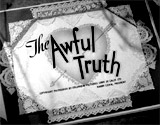

The Awful Truth (1937), 90 minutes, D: Leo McCarey
Director McCarey's classic and zany screwball comedy of the 1930s, filmed previously in 1925 and 1929, was remade as the musical Let's Do It Again (1953). The romantic marital farce was based on Arthur Richman's 1922 play, and featured the first on-screen pairing of Irene Dunne and Cary Grant. One of the earliest scenes was of the divorce proceedings of a distrusting married couple in a courtroom (following an argument and a series of false accusations and suspicions): socialite Lucy (Irene Dunne) and Jerry Warriner (Cary Grant) agreed to a 90-day interlocutory divorce (with a waiting period) - but needed to settle one final matter in the court: a custody battle over their fox-terrier dog Mr. Smith or "Smitty" (Asta of the Thin Man series) who was present in the court. The "final decision" was left up to the dog who was placed equi-distant from them and caught in a dilemma, and eventually chose Lucy by jumping in her lap. With rapid-fire, witty and sophisticated dialogue (and much sarcasm), they each tried their best to thwart or sabotage each other's romances and marriage plans with others, since they both had visiting rights; Lucy was determined to spite Jerry although she wasn't that enthusiastic about various suitors, while Jerry felt that her romances with new people were not worthy of her; at the same time, Jerry made engagement arrangements to cause Lucy to attempt to win him back. While she saw both her handsome French voice teacher Armand Duvalle (Alexander D'Arcy) and wealthy and naive Oklahoma oil heir Daniel Leeson (Ralph Bellamy), he pursued singer Dixie Belle Lee (Joyce Compton) and socialite heiress Barbara Vance (Molly Lamont). In one disruptive scene, Jerry barged in on Lucy's first vocal recital and accidentally tipped back in his chair and noisily fell to the floor, and the two experienced awkward nightclub dates when the couples accidentally turned up with separate dates. In a funny sequence often known as the "two men in a bedroom farce" (regarding dual derby hats and their clever dog "Smitty") - both Armand Duvalle and Jerry arrived at her apartment, but were kept separated; the dog - in a game of hide and seek, persistently kept retrieving and bringing out Duvalle's incriminating derby hat from behind a flower arrangement and a mirror where Lucy had stashed it. In another attempt at sabotage, Lucy pretended to be Jerry's drunk sister after crashing a party at the home of his new fiancee, heiress and debutante Barbara Vance - Lucy delivered a rowdy rendition (with uplifted skirt) of a vulgar nightclub routine and song, My Dreams Are Gone With the Wind, in order to ruin Jerry's relationship. When stranded after an automobile 'accident' on their way to her Aunt Patsy's (Cecil Cunningham) rustic cabin, the couple had to be transported on cops' motorcycles in evening dress. During the final separate but connecting-bedrooms scene in the cabin, the door between their rooms had a weakened and faulty latch and kept opening (on their last night before the 90 day waiting period expired). By the end, the two had reconciled and both discovered the "awful truth" that they still loved each other. At the film's fade-out, there was a metaphoric, sexually-tinged, suggestive image of reunited, male and female cuckoo-clock figurines (stand-ins for Lucy and Jerry) entering the same opening, after the two had realized that they didn't want to marry anyone else.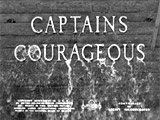




Captains Courageous (1937), 115 minutes, D: Victor Fleming
Rudyard Kipling's tale of adventure, an MGM classic, was remade as two TV movies in 1977 and 1996. A spoiled young heir Harvey Cheyne (Freddie Bartholomew), the son of shipping magnate Mr. Cheyne (Melvyn Douglas) fell overboard from a luxury ocean liner and was rescued by a simple, crusty Portuguese fisherman Manuel (Oscar-winning Spencer Tracy). He was brought on board a New England, Nantucket fishing schooner, and immediately demanded to be brought to shore. They boy was forced to remain onboard for the remaining part of their 3-month fishing trip, and work to earn his keep. He was taught a love of the sea and a valuable series of lessons on life, humility, work, trust, love, and courage. Gradually, he was transformed into a different lad.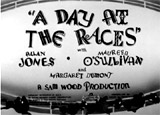



A Day at the Races (1937), 109 minutes, D: Sam Wood
This follow-up film to their successful A Night at the Opera (1935) from a few years earlier was one of the best Marx Brothers films, made during their peak years for MGM, with many memorable scenes and wild comedy routines. In the plot, horse doctor veterinarian Dr. Hugo Hackenbush (Groucho Marx) pretended to be a medical psychiatrist and was hired by a wealthy hypochondriac Mrs. Emily Upjohn (Margaret Dumont) to run the Standish Sanitarium that she was financing for its pretty owner Judy Standish (Maureen O'Sullivan). She was facing liquidation, bankruptcy, and the sale of the institution within a month. Instead, he went to the horse races, where he received racing tips from the sanitarium's bus driver/chauffeur Tony (Chico Marx) in the famous "tootsie-frootsie" ice cream scene. Meanwhile, evil banker Mr. J.D. Morgan (Douglass Dumbrille), with his secret accomplice Whitmore (Leonard Ceeley), the Sanitarium's financial officer, were conspiring to buy the soon-to-foreclose property and convert it into a gambling casino - to supplement Morgan's other holdings including a nearby race track and hotel (with nightclub). Classic scenes included Hackenbush's phone call Impersonation sequence, two medical examination scenes, a clever pantomime (game of charades) by mute horse jockey Stuffy (Harpo Marx) to indicate a frame-up of Hackenbush, the dinner-date seduction of Hackenbush by flirtatious love interest, blonde floozie "Flo" (Esther Muir) who was wallpapered to the wall, scene, Stuffy's destruction of a piano and its transformation into a harp, and the climactic Steeplechase race sequence when Hi-Hat, a horse owned by Judy's boyfriend/fiancee singer Gil Stewart (Allan Jones), was declared the winner - saving the institution.

Dead End (1937), 92 minutes, D: William Wyler
This social crime-drama was adapted from Sidney Kingsley's hit Broadway play by Lillian Hellman. It told about the harsh realities of the ugly, oppressive environment of New York City slums and tenements in the Depression-Era 1930s - a time of poverty and crime. A cold-blooded career gangster Baby Face Martin (Humphrey Bogart) returned to his boyhood neighborhood for a visit - a dead end street in a lower East Side slum, and became an unwelcome influence on the street kids (dubbed the Dead End Kids, and later known as the Bowery Boys). This plot vignette was intercut with two other stories about residents struggling to make a living: the plight of young architect Dave (Joel McCrea) who opposed his boyhood friend Martin and dreamt of rebuilding the depressed waterfront area, and the story of working girl Drina (Sylvia Sidney) whose brother Tommy (Billy Halop), one of the neighborhood Dead End Kids, idolized Martin and was negatively influenced by him.


Fire Over England (1937, UK), 92 minutes, D: William K. Howard
This handsomely-made, opulent costume drama and adventure-film production (cinematography by James Wong Howe) with semi-Shakespearean eloquence, was an Elizabethan historical epic swashbuckler, loosely based on the novel of the same name by A.E.W. Mason (who also authored The Four Feathers). In the story, young British naval officer Michael Ingolby (Laurence Olivier) - after his father was taken prisoner during a ship attack off the Spanish coast by King Philip II (Raymond Massey) of Spain and later burned at the stake during the Inquisition - sought revenge for his father's murder. Back in England, Ingolby's sweetheart was Cynthia (Vivien Leigh in her first major film production, who became Olivier's real-life lover during filming), Queen Elizabeth I's (Flora Robson) lady-in-waiting. Ingolby was commissioned by the Queen to return to Spain (in disguise) to serve as a secret spy to learn about the country's huge Spanish Armada, and to identify traitorous Englishmen. In Spain, Ingolby was able to sabotage the palace, sword-fight with guards, and escape back to England. The film concluded with Ingolby leading Elizabethan England's stand in 1588 during a night attack against the Armada off the coast of England, defeating Spain, and winning knighthood and Cynthia's hand in marriage.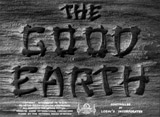


The Good Earth (1937), 138 minutes, D: Sidney Franklin
MGM's beautiful film production - producer Irving Thalberg's last picture - was based upon Pearl Buck's 1931 Pulitzer Prize-winning novel about a peasant couple in rural China. A simple, poor Chinese rice farmer Wang Lung (Paul Muni) wed O-Lan (Best Actress-winning Luise Rainer, two years in a row) in an arranged marriage. They were forced to endure hard labor, poverty, and a severe drought and famine. During government strife and a revolution that swept through the land, their lives were transformed and he became the wealthiest landowner in the province. Their efforts and those of their family disintegrated from his all-consuming greed for money and the devastating effects of a swarm of locusts. In the end, he learned too late that his long-neglected, self-sacrificing, saintly wife was the one who had held everything together.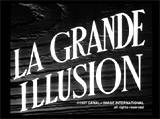

Grand Illusion (1937, Fr.) (aka La Grande Illusion), 114 minutes, D: Jean Renoir
This Nazi-banned, anti-war masterpiece was the first foreign film to be nominated for an Academy Award for Best Picture. In the late 1930s, French filmmaker Jean Renoir attempted to signal a warning about warfare's 'grand illusions' with this classic film, set in a WWI German prison camp in 1916. The film, for the most part, only implied that a war was occurring outside the prison. Aristocratic French officer Captain de Boeldieu (Pierre Fresnay) faced a dilemma regarding his escape with other POWs, including working class mechanic French officer/hero Lieut. Maréchal (Jean Gabin) and wealthy middle-class Jew Lieut. Rosenthal (Marcel Dalio). They were imprisoned and under the watchful eye of stiff German Captain von Rauffenstein (Eric von Stroheim), with a neck brace and wearing a monocle - the commandant of Wintersborn, the German's maximum-security camp. Captain Boeldieu sacrificed himself when reluctantly shot by von Rauffenstein, to allow Marechal and Lieutenant Rosenthal to escape. There was a touching deathbed farewell to Boeldieu from the consoling German commandant. Ultimately, the two escapees took refuge with widowed German farm woman Elsa (Dita Parlo), and found safety and freedom across the Alps and into Switzerland on the border. In the film's last line, one of the soldiers who spotted them shouted: "Don't shoot! They are in Switzerland," to which another responded: "All the better for them."

The Hurricane (1937), 103 minutes, D: John Ford
Director John Ford's spectacular disaster film and tropical fantasy set in the South Seas was followed by an inferior remake in 1979. Its lush film score was composed by Alfred Newman. In the story, a native named Terangi (Jon Hall) from the island of Manakoora married his childhood sweetheart Marama (Dorothy Lamour). Terangi was convicted of attacking a white man and imprisoned. He was repeatedly sentenced to longer and longer terms of imprisonment for making failed escape attempts. His case was appealed to the island's new white governor Eugene De Laage (Raymond Massey), who was a strict by-the-book disciplinarian, although his wife was sympathetic to Terangi's plight. The film ended with a climactic hurricane sequence with great special effects.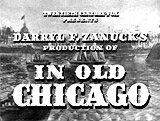

In Old Chicago (1937), 115/95 minutes, D: Henry King
Darryl F. Zanuck's quasi-historical disaster film and romantic drama was designed to take advantage and piggyback upon the success of MGM's previous year's hit San Francisco (1936). The screenplay by Lamar Trotti and Sonya Levien was based on a story by Niven Busch. The Chicago Historical Society assisted in the picture's historical accuracy, although much of the film was fictionalized. The story was about a strong rivalry between two of the three sons of widowed, strong-willed matriarch Mrs. Molly O'Leary (Alice Brady), the one whose cow reportedly kicked over a lantern and started the Chicago fire. Her youngest son was Bob (Tom Brown), a mother's helper who flirted with the pretty Swedish servant Gretchen (June Storey). The two eldest O'Leary sons took very different paths and were in fierce conflict: a virtuous good son - an honest and reforming lawyer Jack (Don Ameche) running for mayor, and a bad son - a corrupt yet charming gambling saloon owner and scheming, devious rogue Dion (Tyrone Power). Dion's assistant was singer Belle Fawcett (Alice Faye), who was also his business partner and lover. Chicago boss Gil Warren (Brian Donlevy) wanted to destroy both brothers. The film climaxed with a spectacular 20-minute sequence of the Chicago fire of 1871, with an abrupt inspirational ending.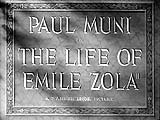



The Life of Emile Zola (1937), 123 minutes, D: William Dieterle
This Best Picture-winning film biography of the famous 19th century French intellectual and novelist was the first film to receive ten Academy Award nominations, and the second biographical film to win the Academy Award for Best Picture after The Great Ziegfeld (1936). Director William Dieterle had directed star Paul Muni in two other historical dramas: The Story of Louis Pasteur (1936), and Juarez (1939). The tale of French novelist and essayist Emile Zola was remade in José Ferrer's film I Accuse! (1958) with a screenplay by Gore Vidal. The film traced the life of Emile Zola (Paul Muni in another of his many biopics) from his youth, as a painter friend of Paul Cezanne (Vladimir Sokoloff) and starving in a Parisian attic, to the peak of his career. He was celebrated as France's greatest writer-author, social critic, and the champion of the oppressed. Zola defended and fought for the pardon and restored reputation of French military army officer Capt. Alfred Dreyfus (Joseph Schildkraut), a Jewish officer in the French army who was wrongly-accused (and unjustly court-martialed) on the charge of treason for providing secret information to the Germans. Dreyfus was clearly framed for treason by his superiors and sentenced to a slow death by life imprisonment on Devil's Island. [Note: The real criminal, French major Count Esterhazy, had divulged French military secrets to the Germans, but was found innocent in a rigged court martial hearing.] When new information came to light about Dreyfus' innocence and it appeared to be a cover-up, Zola risked his own life and fame (it was on the eve of membership to the French academy) by agreeing to defend Dreyfus - the so-called Dreyfus Affair. Zola published his famous manifesto known as "J'Accuse" ("I Accuse") - to directly accuse the French military of ignoring Dreyfus' innocence and falsely convicting him to protect Esterhazy's guilt. As a result, Zola was widely and publically condemned, and criminally prosecuted for libel. The actual trial involving Zola occurred in February 1898. The trial was a farce - Zola was bullied and discredited while crucial evidence was neglected and false claims were made, even though Zola made strong emotional and personal pleas (Zola's final address to the jury in the film was taken from "I Accuse," not from the actual trial). The highlight of the film was Zola's famous six minute self-defense courtroom speech. Zola was convicted and sentenced to a year in prison. However, Zola's conviction was overturned on appeal, although he had already fled to London. Zola was never imprisoned. He returned to Paris, France after 18 months in exile in England, and died an accidental death in 1902 (carbon monoxide poisoning), before the courts fully exonerated Dreyfus in 1906. (Dreyfus was tried a second time, and again convicted and sentenced to 10 years in prison, but quickly pardoned by the French Republic President, and restored to his army rank). At Zola's funeral, he was eulogized by Anatole France (Morris Carnovsky).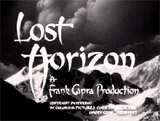




Lost Horizon (1937), 138 minutes, D: Frank Capra
Director Capra's romantic, escapist fantasy was a re-telling of James Hilton's idealistic and naive 1933 book. In the film's opening, escapees and refugees were fleeing from a Chinese revolution in Bakul by boarding boarded a plane bound for Shanghai. The aircraft crash-landed, and five survivors were led through the icy Himalayans by Chinese monk Chang (H. B. Warner) to a magical enchanted paradise - a hidden Tibetan utopia at the top of the world named Shangri-La. There in the peaceful valley, war and death and financial panic were unknown, people lived almost forever (time had stopped), and everyone followed the law of "Be kind." Shangri-La's wisest man was the High Lama (Sam Jaffe), originally known as missionary Belgian priest, Father Perrault, who wished to have one of the group's members, British diplomat Robert Conway (Ronald Colman) become his successor. Conway was a romantic dreamer who believed he had found a new home and a new romantic interest when he fell in love with the ethereally-beautiful Sondra (Jane Wyatt). He was convinced, however, by his younger brother George Conway (John Howard) to leave. The film's most startling scene was when George's Shangri-La lover, 20-year-old Russian girl Maria (Margo) accompanied him and she died an old wrinkled and withered woman (aging by half a century, the time she spent in the valley) as she departed. Despairing and hysterically crazed after an abrupt return to the world of time and death, George committed suicide by throwing himself off a cliff ledge. Conway struggled to get back to England, where he was haunted by his memories of his time in the idyllic valley, especially with Sondra, and he made a valiant effort to return. The film ended with a toast and salute to the missing Conway: "Here's my hope that Robert Conway will find his Shangri-La. Here's my hope that we all find our Shangri-La."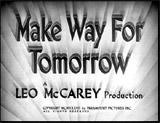


Make Way For Tomorrow (1937), 91 minutes, D: Leo McCarey
Leo McCarey's marriage drama about the harsh realities of aging, was one of the saddest and most poignant and sentimental films ever made (similar to Ozu's Tokyo Story (1953)). It was produced during the weary end years of the long drawn-out Depression. Although beautifully realized, it was not a hit at the box-office and was forgotten for many years. The source for the film was Josephine Lawrence's novel The Years Are So Long. Financially-distraught elderly couple Ma and Pa Cooper - Barkley (Victor Moore) and Lucy (Beulah Bondi), married for 50 years, lost their foreclosed house to the bank when they could not make the mortgage payments. They requested aid from their five children for housing or assistance, and came up with a temporary solution - although the couple were forced to separate: Lucy would move to New York to live in the apartment of eldest son George's (Thomas Mitchell) family, while Barkley would be 360 miles away at the home of mean-spirited daughter Cora Payne (Elisabeth Risdon) and her unemployed husband Bill (Ralph Remley). Accommodations in New York for Lucy were cramped, with George's wife Anita (Fay Bainter) and daughter Rhoda (Barbara Read) upset with the disruption and intrusion. To not be a burden, Lucy ended up in a female retirement-nursing home, and Barkley decided to travel to the warmer climate of California for health reasons, to live with unseen daughter Addie. They shared a heartbreaking farewell at the same NY train station as their honeymoon years earlier, in the film's downbeat ending.



Marked Woman (1937), 99 minutes, D: Lloyd Bacon
Director Lloyd Bacon's and Warner Bros.' hard-boiled, urban crime melodrama about big-city racketeering was based on the real-life story of NYC vice lord Charles "Lucky" Luciano. At the time of this film's making, actress Bette Davis had become disillusioned by the poorly-scripted films being offered to her by Warner Bros. studio. She fled to Europe to further her career, although was brought back to Hollywood by a lawsuit (that she contested and lost) and forced to make the film. It was the story of a spirited nightclub hostess ("prostitute") Mary Dwight Strauber (Bette Davis), who was entrapped and mistreated while working as a call-girl at the Club Intime (a "clip joint" designed to fleece patrons known as suckers), owned and operated by the notorious "Lucky" Luciano-type gangster Johnny Vanning (Edward Ciannelli). Vanning had remodeled the club, renaming it Club Intimate. When party-girl Mary helped debt-owing customer Ralph Krawford (Damian O'Flynn) by loaning him some money to flee town, shortly later he was found murdered. Mary and other girls in her apartment were arrested and interrogated. Special prosecutor and crusading district attorney David Graham (Humphrey Bogart, based on real-life DA Thomas E. Dewey) tried to convince Mary (at first unsuccessfully) to be a key witness to testify against her crooked boss Vanning and his henchman Charlie Delaney (Ben Welden) for eliminating Krawford. She was uncooperative, especially after receiving a visit from Vanning's threatening lawyer (Raymond Hattan). During the court trial when Mary was testifying on the stand, she was browbeaten and demeaned as a cheap floozy and unreliable witness, and the case was ultimately thrown out of court. Mary's innocent younger kid-sister Betty (Jane Bryan), a co-ed student visiting on vacation, had become embroiled in her sister's situation, and claimed she was too ashamed to return to school after being arrested, questioned, and brought to court with Mary. Betty unwisely joined one of Mary's many roommates, Emmy Lou Eagan (Isabel Jewell), and attended a fancy party - unwittingly held at Vanning's club penthouse. The gangster lord intervened when she resisted the unwanted advances of one of Vanning's cohorts Bob Crandall (William B. Davidson), and she was slugged down a staircase to her death. Betty's dumped body was later found in a river. To threaten and scare Mary to not squeal, Vanning scarred her face during a brutal beating, causing her to be hospitalized and making her a "marked woman" with a X-cross on her cheek. This convinced Mary to finally boldly testify in court with other hostesses against the abusive gangster (to convict and sentence him to the electric chair) who had been regularly abusing and mistreating his brothel 'prostitutes'. During the trial, Graham delivered an impassioned speech against racketeering. [Note: In real life in 1936, celebrated Special Prosecutor Thomas E. Dewey put Lucky Luciano behind bars on prostitution charges.] In the concluding scene, unemployed Mary and her girlfriends disappeared into the fog while walking down a nighttime street.




Maytime (1937), 132 minutes, D: Robert Z. Leonard
MGM's musical drama-romance (adapted from Sigmund Romberg's 1917 operetta by Rida Johnson Young) was once very popular but mostly forgotten nowadays. This was the third film that paired Jeanette MacDonald and Nelson Eddy. Some of the musical numbers were: "Mammy's L'il Baby Loves Shortnin' Bread," "Carry Me Back to Old Virginny," and "Czaritza" - an adaptation of Tchaikovsky's 5th Symphony with modern lyrics. In the opening set in the year 1906, elderly and retired opera singer Marcia Morrison (Jeanette MacDonald) lived with her longtime loyal maid Ellen (Rafaela Ottiano) in a New England village. Marcia related in flashback the story of her life forty years earlier as singing diva Marcia Mornay, when she fell in love with poor American baritone singer Paul Allison (Nelson Eddy). They spent an idyllic time together at a May Day festival at the St. Cloud Fair, but she had already promised to marry her celebrated, Svengali-like impresario and voice-trainer Nicolai Nazaroff (John Barrymore). After seven years in a loveless marriage to him, she co-starred with Paul in an American opera production in New York where their love was rekindled, leading to tragic consequences for the two lovers when Nicolai's jealousy overtook them and he shot Paul dead. It concluded with a magnificent sequence of the spiritual images of the doomed lovers meeting together on a flower-strewn path and reprising "Will You Remember (Sweetheart)?"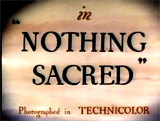

Nothing Sacred (1937), 75 minutes, D: William A. Wellman
Director Wellman's superb screwball comedy (the first filmed in color) satirized the world of tabloid reporting and its corruption and dishonesty. The scriptwriter Ben Hecht, a former newspaperman, also wrote the play "The Front Page" that was made into another famous screwball comedy His Girl Friday (1940). The film was remade as Living It Up (1954) with Dean Martin, Jerry Lewis, and Janet Leigh. In the plot, incompetent Dr. Enoch Downer (Charles Winninger) diagnosed a simple Warsaw, Vermont woman Hazel Flagg (Carole Lombard in her most beloved role) as having only six weeks to live due to radium radioactive poisoning. A small-town newspaper's cynical ambitious reporter Wally Cook (Fredric March), who had already been reprimanded for printing exaggerated stories in the Morning Star, arrived in Vermont to get the exclusive story. In the meantime, Flagg had been told by Dr. Downer that he had mis-diagnosed her, and that she was healthy. Nonetheless, she accepted an all-expenses-paid trip to NYC with Cook, that was designed to honor her courage and heroism. In the big city of New York, she became a national hero (with a ticker-tape parade and presentation of the key to the city). Soon after, her conscience caused her to want to confess the entire hoax about how her diagnosis had been changed and that she was not dying. When the obvious ruse was ultimately about to be revealed, it was decided that Cook and Flagg (who had fallen in love and married) would make their honeymoon getaway to a tropical island, while it was rumored that she had committed suicide with a note left behind.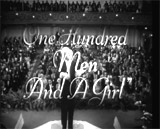


One Hundred Men and a Girl (1937), 85 minutes, D: Henry Koster
This Universal Pictures' backstage musical comedy starred teenaged singing sensation Deanna Durbin - a young Canadian in her second feature-length film after she had appeared in Universal's Three Smart Girls (1936) a year earlier. It won the Academy Award for Best Musical Score. In the plot, unemployed Manhattan trombonist/musician John Cardwell (Adolphe Menjou), the father of young Patricia "Patsy" Cardwell (16 year-old Deanna Durbin), vainly attempted to get a job with conductor Leopold Stokowski (Philadelphia Symphony Orchestra co-conductor playing himself in his first feature film, before his more famous appearance in Fantasia (1940)). With the backing and sponsorship of rich philanthropic socialite Mrs. John G. Frost (Alice Brady) to help out-of-work musicians in the community, the irrepressible Patsy was able to form her own orchestra, comprised of her father and his recruits - 99 of his closest non-working friends (actually the entire Philadelphia Orchestra), and they began rehearsals in a rented garage owned by (Billy Gilbert). When Mrs. Frost left for Europe, Patricia was faced with finding a conductor in order for Mrs. Frost's husband, rich radio station owner Mr. John G. Frost (Eugene Pallette), to agree to sponsor the orchestra. After numerous attempts (including Patsy singing Mozart's Alleluja with the orchestra during a rehearsal, while positioned in various locations in the stage hall), Patricia finally was able to persuade Stokowski to lead the orchestra to give it legitimacy. She did so by sneaking the entire 100 person orchestra into Stokowski's house to play Liszt's Hungarian Rhapsody No. 2 on the staircase for him - inspiring him to spontaneously move his hands and conduct. He was so impressed with her and the group's performance that he accepted her request. In the conclusion of the film, Patsy was introduced by Stokowski during a concert-hall performance of "jobless musicians." She was called to the stage to sing the aria drinking song ("Brindisi") from Verdi's La Traviata, and credited with being "the one who made all this possible."


Pépé le Moko (1937, Fr.), 94 minutes, D: Julien Duvivier
This early pre-film noir, an example of French poetic realism, was remade in the US as Algiers (1938) with Hedy Lamarr and Charles Boyer, and was remarkably similar (in parts) to Casablanca (1942). In the 1930s, Parisian underworld tough-guy yet dashing gangster Pépé le Moko (Jean Gabin) hid out in the Casbah (a winding district of alleys, hideouts, crowded streets and markets) in Algiers, to evade French and Algerian police. After a period of two years ruling but also imprisoned there, he longed to be free and enjoy the good life in Paris and Marseilles. One night after a shootout with authorities, he met gorgeous Parisian socialite Gaby Gould (Mireille Balin), the kept woman of a rich older man (in the champagne business) - and they began a romance. Pépé's jealous lover Inès (Line Noro) taunted him: "No more Paris, no more Marseilles, nothing but the Casbah!" Algerian inspector Slimane (Lucas Gridoux) plotted to arrest Pépé by coaxing him out of the Casbah, using Gaby as attractive bait.




The Prisoner of Zenda (1937), 101 minutes, D: John Cromwell
Director John Cromwell's swashbuckling, dramatic romantic-adventure tale was the best version of the many remakes and versions (1913, 1915, 1922, 1952, and 1979) of Anthony Hope's 1894 novel. Included in the masquerade story were swashbuckling action sword fights and a romance between the commoner/king and the regally-beautiful Princess. The 1952 version, a shot-for-shot remake by MGM, starred Stewart Granger and Deborah Kerr. In this version, the events occurred in the small Central European (Balkan) country of Ruritania (mythical). An Englishman commoner, Major Rudolf Rassendyl (Ronald Colman) was on holiday there in mid-1897. He happened to meet his exact double - look-alike King Rudolph V (also Ronald Colman), his distant half-brother who was about to be coronated. Rudolf arrived by the Orient Express in Strelsau to fish - not to attend the coronation: ("And that's what I came for, fishing, not coronations. I don't like coronations and I do like fishing"). It was recognized by the King's loyal advisors: Capt. Fritz von Tarlenheim (David Niven) and Colonel Zapt (C. Aubrey Smith), that Rudolf closely resembled the monarch. The dissolute King invited Rudolf to his hunting lodge for drinks and toasts - where it was revealed that there was enmity between the King and his half-brother Duke Michael (Raymond Massey), known as "Black Michael," with a band of rebels. The King's soon-to-be-bride was his cousin Princess Flavia (Madeleine Carroll). By morning, the King was found to have been drugged (from wine sent by Michael) and was incapable of being coronated. It was feared by von Tarlenheim that Michael was plotting to usurp the throne in a revolutionary assassination plot. The King's loyal aides proposed that Rudolf might impersonate the King for the day's coronation - a King for a day, while the real King would be hidden away. Michael was plotting behind-the-scenes - bitter because his mother was not of royal blood and the younger Rudolph was the heir to the kingdom. He complained to his French mistress Antoinette de Mauban (Mary Astor). During the coronation march, there was a very surprised look on Michael's face when he heard bugles heralding the arrival of the King (Rudolf in disguise) at the cathedral for the coronation. Michael's plan of usurpation had failed and he dispatched his dashing and villainous chief henchman Rupert of Hentzau (Douglas Fairbanks Jr.) to discover the cause. After the crowning, Rudolf/'King' made the acquaintance with his intended betrothed - his cousin Princess Flavia, who was amazed by his personality change ("You seem an entirely different person"). Complications arose when the real King was kidnapped by Michael's henchman Rupert of Hentzau, while Rudolf was forced to carry on the masquerade, and a search commenced for the abducted King who was being held in a woodcutter's cabin. During the state's coronation ball, Rudolf and Flavia experienced romance together and professed their love for each other. Conflicted by the quandry he was in, Rudolf was about to divulge his real identity when he was interrupted by Col. Zapt. Meanwhile, Rupert of Hentzau was scheming - he promised Michael (in exchange for a handsome fee) to root out the King's imposter. During a secret meeting, Michael's jealous mistress Antoinette (who was betraying Michael by having an affair with Rupert) - divulged to Rudolf where the King was being imprisoned. He was in the midst of being moved from the forest cabin to Michael's castle near Zenda (the King would become "The Prisoner of Zenda"). There was a prolonged goodbye scene between Rudolf and Flavia before he left - he had selflessly volunteered ("Leave that to me") to single-handedly rescue the imprisoned King in the lower dungeon of Michael's castle. Inside the castle, Rudolf observed as Michael found his evil henchman Rupert seducing his own French mistress Antoinette. Michael was lethally stabbed in the abdomen by Rupert. An exciting fencing duel was fought between the villainous Rupert and Rudolf, ending when Colonel Zapt's forces entered the castle and Rupert rapidly fled. In the aftermath - the real King was rescued, recovered and was restored to the throne, and he praised Rudolf for making him sober and clear-headed. A lengthy bittersweet departure scene occurred between Flavia and Rudolf - he apologized and then invited her to leave the kingdom with him for love's sake. After some thought about Rudolf's offer to leave with him, Flavia forfeited her love for Rudolf when she declined to leave the King's side. Rudolf was heartbroken, but ultimately pledged his love to her.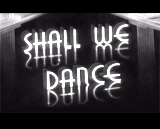


Shall We Dance (1937), 109 minutes, D: Mark Sandrich
This classic RKO film (with an Ira and George Gershwin score) by director Mark Sandrich marked the seventh pairing of the dancing duo of Fred Astaire and Ginger Rogers (of a total of 10 films). It has been often regarded as the last of their classic string of films together. In the predictable story, touring world-famous American ballet star Peter "Petrov" Peters (Fred Astaire) fell in love - even before meeting her - with Linda Keene (Ginger Rogers), a famous musical revue comedy headliner and tap dancer. In Paris while performing in a Russian dance troupe, Peter browsed through a flip book featuring pictures of Linda (animating her images and making her appear to dance) - and it was love at first sight. Although he hadn't met Linda, he vowed to marry her. Meanwhile, the termpermental and frustrated Linda told her near-bankrupt producer-manager Arthur Miller (Jerome Cowan) that she was thinking of quitting show business due to numerous fawning amorous advances by many male suitors or dance partners. At the same time, "Petrov" (who wanted it to appear that he was from Moscow by adopting a thick Russian accent) arrived at an inopportune moment at her apartment to introduce himself to her, but she was unimpressed by his arrogance. The two ended up on the same ship back to the US. One of the film's ongoing misunderstandings was a false rumor perpetrated by Peter's snobbish impresario Jeffrey Baird (Edward Everett Horton) that Peter had been secretly married for four years to ex-ballerina Lady Denise Tarrington (Ketti Gallian), one of his persistent admirers. On board the ship, to rid himself of Lady Tarrington, Peter confirmed the rumor. While sailing on board the ship to NY, Peter and Linda became very well acquainted while strolling with their dogs on deck, leading to the assumption that Peter was married to Linda and that she was pregnant. Linda became outraged and very upset that Peter had used the rumor to get close to her on the ship and to avoid Lady Tarrington. She persuaded the pilot of the mail plane to the ship to take her with him on his return flight to NYC. Once in NY, Linda announced that she was indeed single, and that she had decided to marry a Park Avenue socialite, Jim Montgomery (William Brisbane). Linda's manager Arthur planned a farewell dinner for them in a NYC hotel's rooftop nightclub, as a way to sabotage her marital plans by managing to have her dance with Peter. Arthur remained determined to keep Linda from marrying Jim by reviving the false rumor. Many still believed that they were married after Arthur staged and publicized a photograph of Linda (a life-sized mannequin model) and Peter sleeping together as a married couple. To hide from reporters who wanted to interview them about their 'marriage,' Peter and Linda retreated to Central Park for rowing and roller-skating. She finally suggested a solution to their problem - she would marry him so that she could then promptly divorce him. The two had a quickie marriage in New Jersey, and then returned to New York on the ferry. At first, Linda believed that the marriage was depressing, cueing up Peter's singing of a ballad on the ferry to lighten her mood. Soon after, Linda began to have affectionate and loving feelings for Peter. However, another romantic twist entered - in NY after Linda found Peter with trouble-making Lady Tarrington in their hotel, she decided to pack her bags, stormed out, and initiated divorce proceedings. Peter turned disconsolate after their scandalous breakup, and after learning that his opera-house show with the Metropolitan Balley Company had been cancelled. To help the desperate Peter, Arthur offered to feature him in his upcoming musical revue at his nightclub's roof garden. The film's happy ending was concluded with the title number "Shall We Dance" featuring Peter dancing with dozens of chorus girls (with multiple 'Linda' masks - an idea copied from Dames (1934)) and solo dancing with Linda herself. Although Linda arrived to serve him divorce papers, she softened when she saw Peter dancing with a chorus of dancers wearing Linda masks, and realized that their love was real. Linda changed into one of the matching dancing costumes (with a mask), joined the chorus onstage, and then after being unmasked, she danced with Peter as they were reunited.


Snow White and the Seven Dwarfs (1937), 82 minutes, D: Disney Studios (David Hand)
Disney's first full-length animated feature (and the first in film history), based on the Brothers Grimm imaginative storybook fairy tale, became one of the most culturally significant films ever made. The film was costly at $1.7 million, and took 3-4 years to complete. It was timeless classic with sing-along-songs, including: "Heigh Ho," "Whistle While You Work," and "Someday My Prince Will Come." The animation was the story of a young, beautiful but victimized, rags-wearing servant girl Snow White who was brought up by her evil stepmother, the vain, wicked and jealous queen. When told that the "fairest of them all" was Snow White, the queen had her huntsman take Snow White to the forest to kill her and return with her heart. The huntsman could not carry out the gruesome task, and freed Snow White, who ran into the forest and was adopted by woodland creatures. She sought refuge in the cottage of the loveable seven dwarfs, diamond-mine workers. When the wicked, jealous queen learned from her Magic Mirror that Snow White was still alive, she transformed herself into an old hag beggar woman, and offered Snow White a bite from a poisoned apple. Snow White entered into a comatose deep sleep (within a glass-and-gold coffin) until she was awakened from the sleeping death by Prince Charming's loving kiss.
Song at Midnight (1937, China) (aka Ye Ban Ge Sheng), 113 minutes, D: Weibang Ma-Xu
Song at Midnight was first Chinese horror film. It was remade as Ronny Yu's bigger-budgeted Phantom Lover (1995) starring Leslie Cheung, and was a variation or reinterpretation of Gaston Leroux's novel The Phantom of the Opera and Rupert Julian's film The Phantom of the Opera (1925) with Lon Chaney, Sr. In the artistically-made work of art, opera singer Song Dan-ping (the Erik the Phantom anti-hero character) (played by Jin Shan), fell in love with Li Xiaoxia (Ping Hu), the daughter of General Wan-Yin (Woo Ping). The disapproving father punished Dan-ping by disfiguring his face with acid. Mutilated and feeling shameful about his looks, Dan-ping spread the rumor that he was dead, causing his lover to go mad with grief. Ten years later, a young opera singer Sung Xiaoou (Chau-Shui Yee) met Dan-ping by accident hiding in the opera house, and discovered his fateful past.



Stage Door (1937), 83 minutes, D: Gregory La Cava
Director Gregory La Cava both helmed the fast moving film and helped to rework (rewrite) the script - a film adaptation based on the Edna Ferber/George S. Kaufman Broadway hit play. It was an entertaining Hollywood backstage, behind-the-scenes comedy/drama of the lives and ambitions of actresses and stage hopefuls who lived together in a theatrical boarding house. The brisk and funny comedy contained great, sharp-tongued dialogue and a realistic, almost all-girl cast. In the story, a New York boarding house known as the Footlights Club was stocked with hopeful, competitive and very talkative theater actresses (portrayed by many future famous stars of the late 30s and 40s). They included the privileged, aristocratic and wealthy debutante Terry Randall (Katharine Hepburn) who was trying to make it on her own without the help of her family's money, her complete-opposite rival and sarcastic, flippant tough-cookie roommate Jean Maitland (Ginger Rogers), high-strung, very poor, sensitive and depressed aspiring actress Kaye Hamilton (Andrea Leeds) who was very popular with everyone, and wisecracking Eve (Eve Arden). Jean reluctantly allowed leering and cynical Broadway producer mogul Anthony Powell (Adolphe Menjou) to take her out (and attempt to seduce her in his penthouse) only to insure her future employment and stardom, although she was warned about Powell's motives by one of his already cast-aside paramours Linda Shaw (Gail Patrick). In addition, the pushy Terry was offered the lead role by Powell in his new play titled Enchanted April (the role coveted by Kaye) - at first, she was unaware that she got the part because her rich and influential father Harry Sims (Samuel S. Hinds), known as the "Wheat King," had backed and financed the production. [Note: Sims actually hoped Terry would be a failure as an actress so she could pursue some other more traditional career.] Terry's acquisition of the role caused despair and jealousy among the others, including the broken-hearted Kaye who suicidally killed herself by jumping from an upstairs window. At the theater on Terry's opening night, she was notified of Kaye's demise, and at first hesitated to proceed, but then gave a moving performance to everyone's surprise (beautifully reciting: "The calla lillies are in bloom again"), and was praised as a new and upcoming star.

A Star is Born (1937), 111 minutes, D: William A. Wellman
This compelling Technicolored film was the first of four films (and was noted as the only non-musical version) - followed by three remakes: A Star Is Born (1954) with Judy Garland and James Mason, A Star is Born (1976) with Barbra Streisand and Kris Kristofferson, and A Star is Born (2018) with director/star Bradley Cooper and Lady Gaga. The character study was one of the best of Hollywood's behind-the-scenes tragic dramas, featuring a star-crossed romance. The Oscar-winning script borrowed from the lives of real-life Hollywood failures, including John Gilbert, John Barrymore, and Wallace Reid. Charming, talented young newcomer/hopeful Esther Blodgett (Janet Gaynor) departed from her North Dakota farm-home to find promised fame, fortune, and stardom in Hollywood. Upon her arrival by train, she first visited Grauman's Chinese Theatre where she stepped into the footprints of her screen idol Norman Maine. She found work as a waitress at a fancy catered Hollywood party, where she met successful, suave, and aging superstar actor Norman Maine (Fredric March), known for his heavy drinking. With his influence, she was introduced to powerful Hollywood figures, including Norman's long-time friend and studio producer/director Oliver Niles (Adolphe Menjou). It was arranged for Esther to have a screen test, before she was transformed and enjoyed a meteoric rise to stardom. During her star-building process, she acquired a new screen name for her manufactured character - she was renamed Vicki Lester. After being discovered, her career blossomed and in her first film The Enchanted Hour, she starred opposite Norman, and received rave reviews, although there were disparaging reviews for Norman's performance. She fell in love with Norman and they married (by secretly eloping to a small town courthouse for the ceremony). They purposely avoided a fantasy wedding proposed by Hollywood's publicity department and its head Matt Libby (Lionel Stander). In contrast to Vicki, Norman's career went into a slow decline, due to a self-destructive streak and his rampant alcoholism. He became unemployable, and the studio offered to cancel and buy out his contract as he sank deeper into alcoholism. Vicki/Esther announced that she would abandon her career to take care of Norman, who had already visited a sanitarium and jail (for driving intoxicated). After learning of Vicki's self-sacrifice, Norman met a despairing suicidal end by walking out into the ocean from their Malibu beach house to drown himself, to avoid ruining Vicki's career. After Norman's funeral, Vicki reluctantly returned to the screen. During the debut of her new film at the Grauman's Chinese Theatre, she triumphantly and proudly stepped forward to a microphone to tell the audience: "Hello everybody, this is Mrs. Norman Maine."

Stella Dallas (1937), 106 minutes, D: King Vidor
Director King Vidor's classic, best-known and popular dramatic tearjerker/soap-opera originated as the 1923 best-selling novel by Olive Higgins Prouty, then as a play (without a Broadway run), and also as a daytime radio serial that played for 18 years. It was the most memorable version of three filmed attempts (including Henry King's silent film in 1925 starring Belle Bennett and Ronald Colman, and a feature film in 1990 titled only Stella with Bette Midler). It told about clashing social values and a devoted but frustrated mother's sacrificial love. The film was the touching and often poignant portrayal of upwardly mobile, small-town, kind, good-hearted Massachusetts textile mill-girl Stella Martin (Barbara Stanwyck) who married down-on-his-luck heir Stephen Dallas (John Boles), the son of a suicidal, well-known financier. Their marriage was troubled from the start, due to their very different social class upbringings. She entered into money when he became a successful businessman (as the mill's assistant manager), but was never able to escape her vulgar, loud, hard-living and coarse middle-class ways. After a year, they had a baby girl named Laurel, bringing out Stella's maternal instincts, but by this time, Stella had already become estranged from Stephen who had been transferred to the company's branch office in New York. She completely lost her husband when he associated himself with a former love and fiancee - the now-widowed, society-bred Helen (Dale) Morrison (Barbara O'Neil). Stella's daughter Laurel (Anne Shirley) began attending a Boston-area boarding school, and also became close to her father and his more privileged and opulent way of life, while becoming further estranged from her mother. In an attempt to provide better circumstances for Laurel, Stella took her to a fancy resort where she met Richard Grosvenor III (Tim Holt) from a wealthy family. Ultimately, Stella decided to give up her daughter to her wealthy father (and to assent to a divorce so that Stephen and Helen could provide a proper home for Laurel) in a supreme act of self-sacrifice and selflessness. She affirmed she would not get in the way of her daughter's happiness or her social and romantic aspirations (to allow the deserved Laurel to marry into a wealthy family). To prompt Laurel to give her up, Stella feigned drunkenness and an affair with loutish race-track gambler-friend Ed Munn (Alan Hale), and announced her intentions to marry Ed and travel to South America. The tearjerking ending on the day of Laurel's wedding some years later was unforgettable. Out on the dark and rainy city street, Stella watched from afar through the open living room curtains of the Dallas' New York house, as her daughter exchanged wedding vows and kissed her newly-wed husband.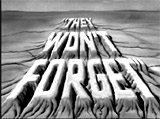


They Won't Forget (1937), 94 minutes, D: Mervyn LeRoy
The setting for this liberal outrage film was the small (fictional) Southern town of Flodden, Georgia in the 1920s, where townsfolk (especially Civil War veterans) were preparing for the annual Confederate Memorial Day parade. The film opened with the murder of Buxton Business College student Mary Clay (this was the debut film of Lana Turner - a bit part including her famous tight-sweater walk), whose body was found by black janitor Tump Redwine (Clinton Rosemond) in the school's basement. Present close to the murder scene were Mary's shorthand teacher Robert Perry Hale (Edward Norris) - an unhappily-transplanted Yankee Northerner, the frightened Redwine, and Dean Buxton (E. Alyn Warren). Ambitious D.A. Andy Griffin (Claude Rains) saw the case as his ticket to the Senate - and he immediately suspected Hale, who was arrested. Detective Pindar (Granville Bates) was assigned to investigate, while weak defense attorney Michael Gleason (Otto Kruger) was selected to defend Hale, who was viciously subjected to anti-northern prejudice, local anger and hate, fueled by reporter Bill Brock (Allyn Joslyn) and Mary's vengeful redneck brothers who wanted a lynching. [Note: The story was directly based on the notoriously lawless Leo Frank lynching in Marietta, Georgia in 1915 after the murder of Mary Phagan.] During the trial - a gross miscarriage of justice with many instances of perjury, the histrionic Griffin basically presented 'circumstantial evidence' to vilify Hale as the guilty one: (1) there was blood on Hale's coat (Hale claimed it was from a shave on Main St., although the barber lied and denied it), (2) the unfortunate fact that Hale was planning to quit and leave town at the time of the murder. Hale took the stand and pleaded his innocence, but was not cross-examined. The jury swiftly brought a guilty verdict (although one juror wavered briefly), affirmed by the Supreme Court, although Governor Mountford (Paul Everton) commuted the death sentence to life imprisonment. The train carrying Hale to prison was stopped by a lynch mob (led by the Clay brothers) - and Hale was hanged. Hale's guilt or innocence was never clarified.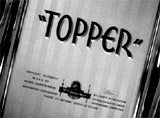



Topper (1937), 98 minutes, D: Norman Z. McLeod
This delightful comedy/fantasy was followed by two sequels: Norman Z. McLeod's Topper Takes a Trip (1938) (without Cary Grant) and Roy Del Ruth's Topper Returns (1941), and then a 1953-1955 TV series with Leo G. Carroll as the title character, and two TV movies, Topper (1973) (with Roddy McDowall) and Topper (1979) (with Jack Warden). It told about a free-spirited, wealthy, fun-loving couple named George (Cary Grant) and Marion Kerby (Constance Bennett), with wealth, fast cars, and excessive partying. The happy-go-lucky married duo were killed in an auto accident when they crashed their roadster into a tree. Before they were granted entrance to heaven, however, they had to perform a good deed for their stuffy bank president - to teach mild-mannered proper Cosmo Topper (Roland Young) to liven up, relax and enjoy life's pleasures. They appeared at will as haunting invisible ghosts, often at awkward moments, but were only seen by Topper - taking pleasure at embarrassing him in humorous predicaments. In one hilarious scene, the Kerbys helped the drunken Topper down a hotel staircase and through the lobby.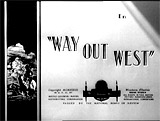


Way Out West (1937), 65 minutes, D: James W. Horne
Way Out West was possibly the best Laurel and Hardy comedy (with tremendous slapstick), and occurred in a western setting. Stan Laurel (Himself) and Oliver Hardy (Himself) agreed to deliver a gold mine deed and map for deceased prospector friend/partner Seymore "Sy" Roberts (Tex Driscoll). They traveled west to Brushwood Gulch to give the rightful inheritance, including the deed and map, to the prospector's daughter Mary Roberts (Rosina Lawrence), but along the way, a crooked bartender Mickey Finn (James Finlayson) learned of their mission and persuaded his floozy barmaid/girlfriend Lola Marcel (Sharon Lynne) to pose as an imposter and hijack the map and deed. When the two learned they were deceived, they had to get the map back and rescue the girl. Included a delightful soft-shoe dance sequence of the comedic pair to "At the Ball, That's All," the singing of "The Trail Of The Lonesome Pine," a hilarious chase scene to get the deed, Stan's tickling-to-death scene, the attempt to sneak into the saloon using Dinah the Mule, and the concluding song: "We're Going to Go Way Down to Dixie."